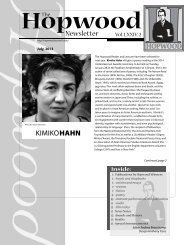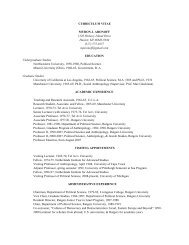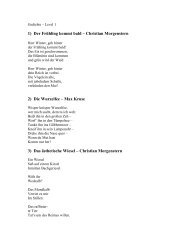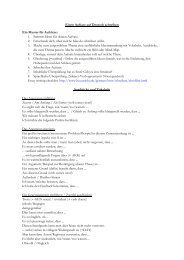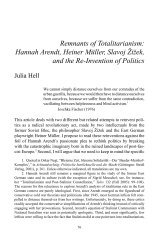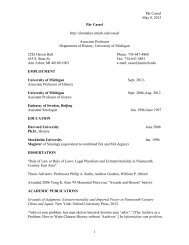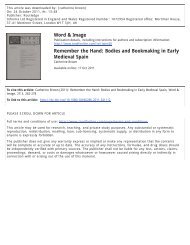Making History Personal: Constantine Cavafy and the Rise of Rome
Making History Personal: Constantine Cavafy and the Rise of Rome
Making History Personal: Constantine Cavafy and the Rise of Rome
You also want an ePaper? Increase the reach of your titles
YUMPU automatically turns print PDFs into web optimized ePapers that Google loves.
Frier, “<strong>Making</strong> <strong>History</strong> <strong>Personal</strong>,” page 33<br />
tion <strong>of</strong> two ancient sources is accompanied by <strong>Cavafy</strong>’s calculated addition <strong>of</strong> plausible detail in<br />
order to emphasize <strong>the</strong> <strong>the</strong>mes that he considers important. At times this addition may be largely<br />
ephemeral, a shift in viewpoint or an exp<strong>and</strong>ed description; at o<strong>the</strong>r points, however, <strong>Cavafy</strong> en-<br />
gages in more heroic construction <strong>of</strong> his own distinctive poetics, such as occurs, for instance, in<br />
“Caesarion” (1914) or in “Maker <strong>of</strong> Wine Bowls” (1903/1912), where <strong>Cavafy</strong> sounds his great<br />
central <strong>the</strong>mes <strong>of</strong> <strong>the</strong> fragility <strong>of</strong> beauty <strong>and</strong> <strong>of</strong> <strong>the</strong> poet’s power <strong>and</strong> duty to preserve it. 107<br />
<strong>the</strong> broader crux is that reconstruction <strong>of</strong> <strong>Cavafy</strong>’s hermeneutical dialogue with his sources is<br />
crucial to fully comprehending his historical poems. Although even <strong>the</strong> most esoteric poems<br />
(such as “Orophernes,” 1904) may appeal to naïve readers simply through <strong>Cavafy</strong>’s forceful<br />
presentation, <strong>the</strong>ir pr<strong>of</strong>undity is, in most instances, enormously enhanced through careful histori-<br />
cal analysis, just as <strong>Cavafy</strong> evidently intended.<br />
If we turn now to <strong>the</strong> wider contest <strong>of</strong> <strong>the</strong> historical “cycles” that <strong>the</strong>se individual poems<br />
comprise, it becomes relatively easy to see how <strong>Cavafy</strong> used <strong>the</strong> poems in order to fashion a<br />
bridge from his own world—mainly, <strong>the</strong> contemporary city <strong>of</strong> Alex<strong>and</strong>ria—backward to <strong>the</strong> spe-<br />
108<br />
cific periods <strong>of</strong> <strong>the</strong> past that, for one reason or ano<strong>the</strong>r, caught his attention. The poems asso-<br />
ciated with each <strong>of</strong> <strong>the</strong>se “isl<strong>and</strong>s” <strong>of</strong> history do, for <strong>the</strong> most part, form a unified <strong>and</strong> harmo-<br />
nious whole, even if <strong>the</strong>y do not necessarily rise to <strong>the</strong> level <strong>of</strong> a “cycle.” But <strong>Cavafy</strong>’s larger<br />
process has two fur<strong>the</strong>r aspects, one negative <strong>and</strong> one positive. On <strong>the</strong> one h<strong>and</strong>, <strong>Cavafy</strong> artfully<br />
constructs, for instance, an elaborate (<strong>and</strong> largely fictitious) cultural continuity between early<br />
twentieth-century Alex<strong>and</strong>ria <strong>and</strong> <strong>the</strong> Greco-Roman East, while virtually omitting both <strong>the</strong> pre-<br />
ceding feats <strong>of</strong> Alex<strong>and</strong>er <strong>the</strong> Great <strong>and</strong> <strong>of</strong> <strong>the</strong> founders <strong>of</strong> <strong>the</strong> great Hellenistic dynasties, <strong>and</strong><br />
<strong>the</strong> subsequent millennium <strong>of</strong> Arab occupation—periods, for <strong>Cavafy</strong>, <strong>of</strong> little or no personal in-<br />
terest. 109<br />
On <strong>the</strong> o<strong>the</strong>r h<strong>and</strong>, <strong>the</strong> intimate ties he creates with <strong>the</strong> past enable him, as we have<br />
seen, to comment on his own time—in particular, on political or social issues he was o<strong>the</strong>rwise<br />
loath to discuss directly—through <strong>the</strong> oblique lens <strong>of</strong> historical experience.<br />
107<br />
Jusdanis, Poetics (1987) 8-15, 89-95, 107-108.<br />
108<br />
This is also true for <strong>the</strong> “cycle” on Julian, see above all Bowersock, “Julian Poems” (1981/2009), <strong>and</strong> “New<br />
<strong>Cavafy</strong>” (1996/2009); <strong>and</strong> that on Apollonius <strong>of</strong> Tyana, see Bowersock, “Apollonios” (1983/2009). As to <strong>the</strong> third<br />
century BCE, <strong>Cavafy</strong>’s attention seems captured mainly by Plutarch’s Life <strong>of</strong> Cleomenes, <strong>and</strong> a bit by his Life <strong>of</strong><br />
Demetrius <strong>the</strong> Besieger (“King Demetrius,” 1906).<br />
109<br />
See Keeley, Alex<strong>and</strong>ria (1976) 88, who notes <strong>the</strong> exception: “Fugitives” (1914), in which a h<strong>and</strong>ful <strong>of</strong><br />
ninth-century Greeks struggle to maintain Greek culture in Alex<strong>and</strong>ria; see also Pinchin, Alex<strong>and</strong>ria Still (1977) 69-<br />
70.<br />
But



